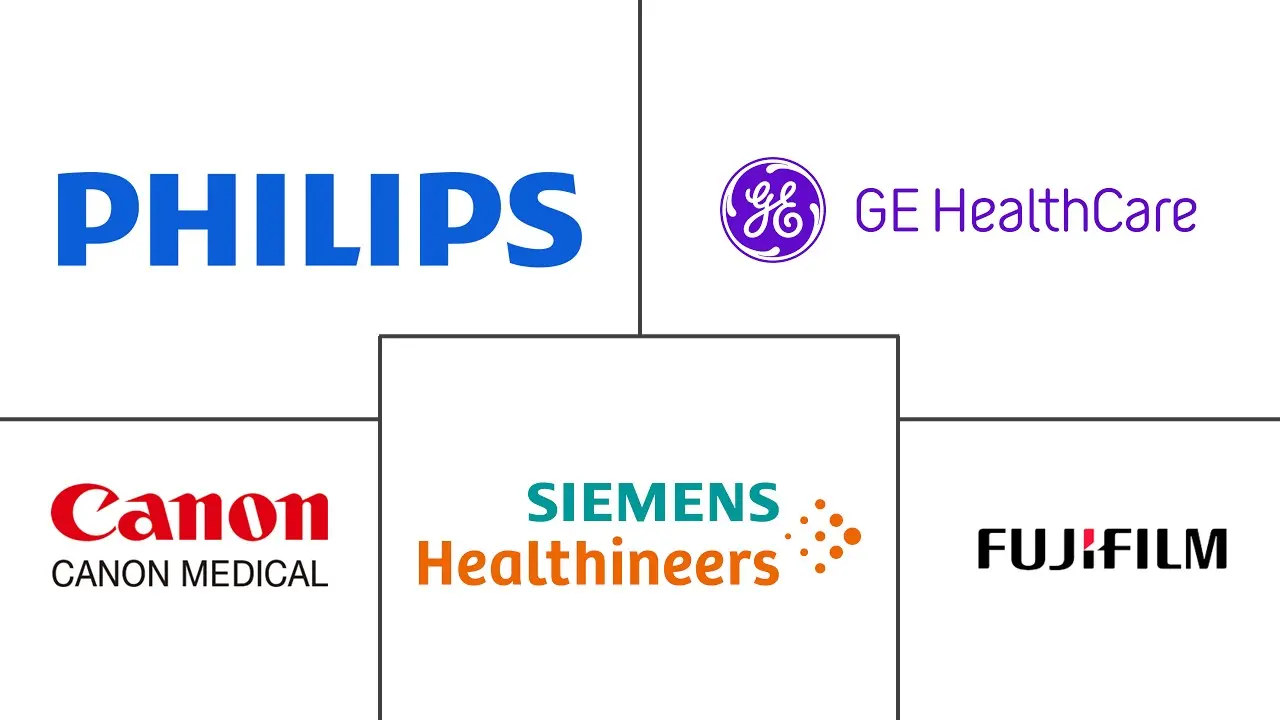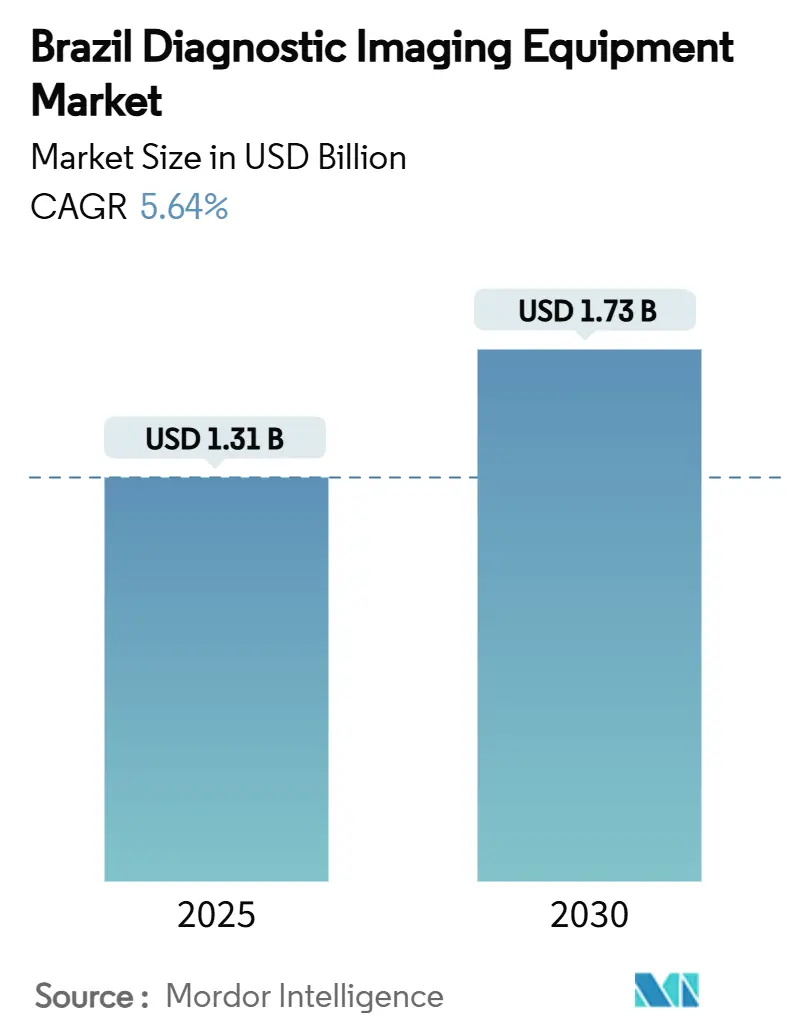
Brazil Diagnostic Imaging Equipment Market Analysis by Mordor Intelligence
The Brazil Diagnostic Imaging Equipment Market size is estimated at USD 1.31 billion in 2025, and is expected to reach USD 1.73 billion by 2030, at a CAGR of 5.64% during the forecast period (2025-2030). The upbeat outlook mirrors Brazil’s position as Latin America’s largest healthcare arena, where public-sector funding climbed 46% year on year to R$ 218 billion in 2024, creating a sizeable replacement cycle for outdated analog systems and encouraging higher capital expenditure on advanced modalities.[1]Source: Saúde Business, “Saúde pública em 2024: investimentos prometem ser maiores,” saudebusiness.com High chronic-disease prevalence, an aging population, expanded private insurance uptake, and streamlined ANVISA rules foster wider equipment penetration, while digital health initiatives stimulate migration to AI-ready platforms and workflow software that improve image throughput and reduce technician workload. Industry leaders accelerate product localization and cloud-based aftermarket services to manage the country’s import dependency and currency volatility, while domestic innovators gain traction by tailoring portable ultrasound and AI triage solutions to remote regions with few radiologists.
Key Report Takeaways
- By modality, X-ray systems led with 22.33% revenue share in 2024, and MRI logged the highest projected 7.96% CAGR through 2030.
- By portability, fixed systems captured 82.21% of Brazil diagnostic imaging equipment market share in 2024, whereas mobile and handheld units are expected to post a 7.23% CAGR to 2030.
- By application, oncology accounted for 26.54% share of Brazil diagnostic imaging equipment market size in 2024, with neurology forecast to accelerate at an 8.13% CAGR during the outlook period.
- By end-user, hospitals held 58.65% of Brazil diagnostic imaging equipment market share in 2024, while diagnostic imaging centers are anticipated to advance at a 6.85% CAGR up to 2030.
Brazil Diagnostic Imaging Equipment Market Trends and Insights
Drivers Impact Analysis
| Driver | (~) % Impact on CAGR Forecast | Geographic Relevance | Impact Timeline |
|---|---|---|---|
| Growing Burden of Chronic Diseases | +1.2% | National, concentrated in Southeast and South regions | Long term (≥ 4 years) |
| Demographic & Epidemiologic Shift Toward Aging Population Raising Imaging Demand | +0.9% | National, with higher intensity in urban centers | Long term (≥ 4 years) |
| Digital Transformation of Healthcare Stimulating Replacement of Legacy Analog Systems | +0.8% | National, led by Southeast, expanding to Northeast | Medium term (2-4 years) |
| Decentralized Care & Telemedicine Catalyzing Mobile / Point-of-Care Imaging Adoption | +0.7% | National, highest impact in North and Northeast regions | Medium term (2-4 years) |
| Government and Public Health Investments | +0.6% | National, prioritizing underserved regions | Short term (≤ 2 years) |
| Private Diagnostic Chain Expansion and Medical Tourism | +0.5% | Southeast and South regions, expanding nationally | Medium term (2-4 years) |
| Source: Mordor Intelligence | |||
Growing Burden of Chronic Diseases
Cardiovascular conditions remain Brazil’s top mortality cause, while the five most common cancers now form nearly one half of new cases, pushing continuous demand for multi-slice CT, PET/CT and cardiac ultrasound platforms that refine staging and risk stratification.[2]Source: Bittencourt M. et al., “Estatística Cardiovascular – Brasil 2023,” scielo.br AI triage and image-sharing networks enable over-burdened radiology departments to handle higher study volumes without proportional staff growth. Regional incidence variability, such as rising prostate cancer in Mato Grosso, forces providers to scale modality mix to local epidemiology. Mobile lung-screening programs like ProPulmão display how low-dose CT vehicles can extend oncologic imaging to underserved smokers in resource-poor municipalities. Public and private hospitals consequently adjust equipment budgets toward advanced hybrids and iterative-reconstruction software that shorten scan times and lower dose.
Demographic & Epidemiologic Shift Toward Aging Population Raising Imaging Demand
Life expectancy has recovered to 77.4 years for women and 70.2 years for men, and elders consume far more diagnostic studies for oncologic, neurologic, and musculoskeletal disorders. Urban facilities wrestle with a backlog as scan referrals multiply, whereas rural regions face outright service absence because one-third of Health Regions still lack key imaging procedures. The shortfall encourages the procurement of compact MRI and portable ultrasound units that operate on limited infrastructure. Private insurers covering 25% of Brazilians work with outpatient centers to shorten wait times, often leasing vendor-managed equipment to sidestep ample cash outlays and speed adoption of AI-assisted protocols that condense exam slots and improve throughput.
Digital Transformation of Healthcare Stimulating Replacement of Legacy Analog Systems
COVID-19 boosted tele-expertise acceptance, demonstrated by the UBS+Digital program’s 85% case-resolution rate for more than 6,300 teleconsults in 2023.[3]Source: Rocha A., “Telehealth Initiative to Enhance Primary Care Access in Brazil,” jmir.org Government e-health plans now require PACS-ready hardware and cloud APIs, steering providers toward detector-based radiography, low-field MRI, and vendor-neutral archives. GE Healthcare, Siemens Healthineers, and Philips each bundle remote console control or slice-time AI tools, enabling scarce radiologists in São Paulo to supervise scans in Amazonia. Hospital CFOs favor the predictable operating expense of subscription algorithms that boost magnet uptime and shorten exam slots, which together accelerate return on newer high-field systems. As AI conformity becomes a tender criterion, legacy analog rooms lose reimbursements and propel a replacement super-cycle within the Brazil diagnostic imaging equipment market.
Decentralized Care & Telemedicine Catalyzing Mobile / Point-of-Care Imaging Adoption
Vast geography, spotty road access, and ICU scarcity in Northern states motivate demand for light-weight, battery-operated ultrasound, DR and CT trailers that travel to mining camps and primary-care hubs. Brazilian firm Mobissom sells wireless probes that link to smartphones, supporting obstetric screening and trauma triage miles from tertiary centers. FDA-cleared Digital Expert Access allows radiologists to remotely drive GE scanners, lifting productivity where technologists are untrained. Cancer campaigns deploy mobile PET units on rotating schedules, ensuring high-risk populations obtain guideline-based surveillance without city trips. The use patterns broaden Brazil diagnostic imaging equipment market exposure beyond capital cities and accelerate volume growth in portable sub-segments.
Restraints Impact Analysis
| Restraint | (~) % Impact on CAGR Forecast | Geographic Relevance | Impact Timeline |
|---|---|---|---|
| High Up-front Capital Costs & Long ROI Horizons for Smaller Hospitals | -0.8% | National, acute impact on interior and rural regions | Long term (≥ 4 years) |
| Shortage of Skilled Professionals | -0.6% | National, severe in North and Northeast regions | Long term (≥ 4 years) |
| Import Dependence Exposing Market to Exchange-Rate & Supply-Chain Disruptions | -0.5% | National, with regional variations in impact severity | Medium term (2-4 years) |
| High Maintenance and Infrastructure Requirements | -0.4% | National, concentrated in regions with limited technical support | Medium term (2-4 years) |
| Source: Mordor Intelligence | |||
High Up-front Capital Costs & Long ROI Horizons for Smaller Hospitals
Acquisition prices for 1.5 T MRI or 128-slice CT often exceed USD 1 million, a threshold out of reach for many interior hospitals that also face SUS reimbursement ceilings, which elongate payback to beyond seven years. The R$ 250 million fund launched by Ouro Preto Investimentos offers vendor-neutral leaseback schemes, but adoption remains modest outside large cities. Several Health Regions, therefore, run without stroke-ready CT, forcing patient transfers that inflate clinical risk and erode ROI for prospective buyers. Refurbished imports help, yet equipment age raises downtime risk and upgrade incompatibility, perpetuating cycle lags within the Brazil diagnostic imaging equipment market.
Shortage of Skilled Professionals
Radiologists cluster in São Paulo and Rio de Janeiro while northern municipalities rely on teleradiology contracts or locums, resulting in under-utilization of installed scanners and lower procedure turnover. UBS+Digital showed that targeted tele-training of 342 staff can bridge gaps, yet sustainable capacity requires long-term incentives for specialists to relocate. Remote scanning software from GE and Philips softens expertise deficits, but high-end neuro‐oriented MRI still needs on-site physicists for QA. The bottleneck tempers modality diversification in remote markets and caps achievable volume growth.
Segment Analysis
By Modality: Advanced Imaging Drives Market Evolution
The Brazil diagnostic imaging equipment market size for X-ray systems commanded 22.33% in 2024 and remained the entry-level workhorse in public and private clinics. MRI is set to rise at a 7.96% CAGR given oncology follow-up, multiple-sclerosis monitoring and cardiac viability mapping.
Portable ultrasound scales fast in antenatal programs while fluoroscopy-C-arm combos like Siemens Luminos Q.namix attract surgical centers seeking unified low-dose interventional suites. Hybrid PET/MRI broadens breast and cervical staging, signaling a future high-margin niche. Nuclear medicine lags broader adoption due to radioisotope logistics, but gains impetus from expanding oncology centers, which boosts the overall Brazil diagnostic imaging equipment market.
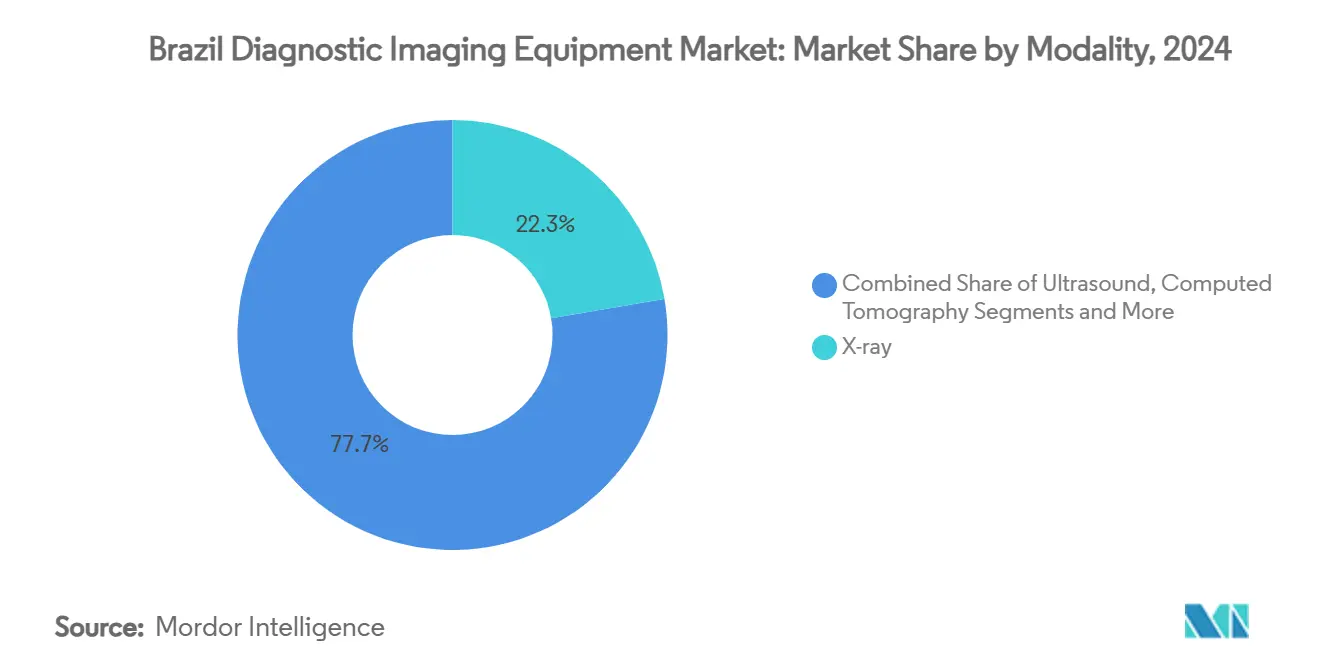
Note: Segment shares of all individual segments available upon report purchase
By Portability: Mobile Solutions Address Geographic Challenges
Fixed installations still furnish 82.21% of Brazil diagnostic imaging equipment market share because high-field magnet and multi-row CT siting needs tie them to anchor hospitals. Mobile and handheld systems will post 7.23% CAGR as teleradiology coverage and state-financed screening trucks fill regional accessibility gaps. Mobile imaging solutions become particularly critical for cancer screening initiatives like the ProPulmão project, utilizing mobile low-dose computed tomography units to reach high-risk populations in limited resource regions.
Wireless ultrasound probes from Mobissom and truck-mounted MRI from Resonandina display how vendors tailor form factors to Brazil’s long-distance referral patterns. The success of UBS+Digital incentivizes primary-care clinics to add compact DR panels connected to cloud PACS, advancing decentralization and sustaining double-digit unit growth in portable categories of the Brazil diagnostic imaging equipment market.
By Application: Oncology Leadership Reflects Disease Burden
Oncology’s 26.54% share of Brazil diagnostic imaging equipment market size in 2024 aligns with breast, prostate and colorectal cancer dominance and tobacco-linked lung cancer prevalence. Neurology is projected at an 8.13% CAGR, propelled by dementia tracking and stroke intervention protocols that rely on perfusion CT and functional MRI. Cardiology stays robust given ischemic disease surveillance, while orthopedics benefits from sports injuries and an aging cohort with degenerative joint disease.
Orthopedics imaging benefits from Brazil's active population and sports medicine development, while obstetrics and gynecology applications remain essential for maternal healthcare across the country's diverse demographic regions. The Centro Médico São José exemplifies private sector investment in oncology imaging, with AI-equipped MRI machines from GE Healthcare serving approximately 300 patients daily and providing advanced diagnostic capabilities previously unavailable in São Paulo's interior regions.
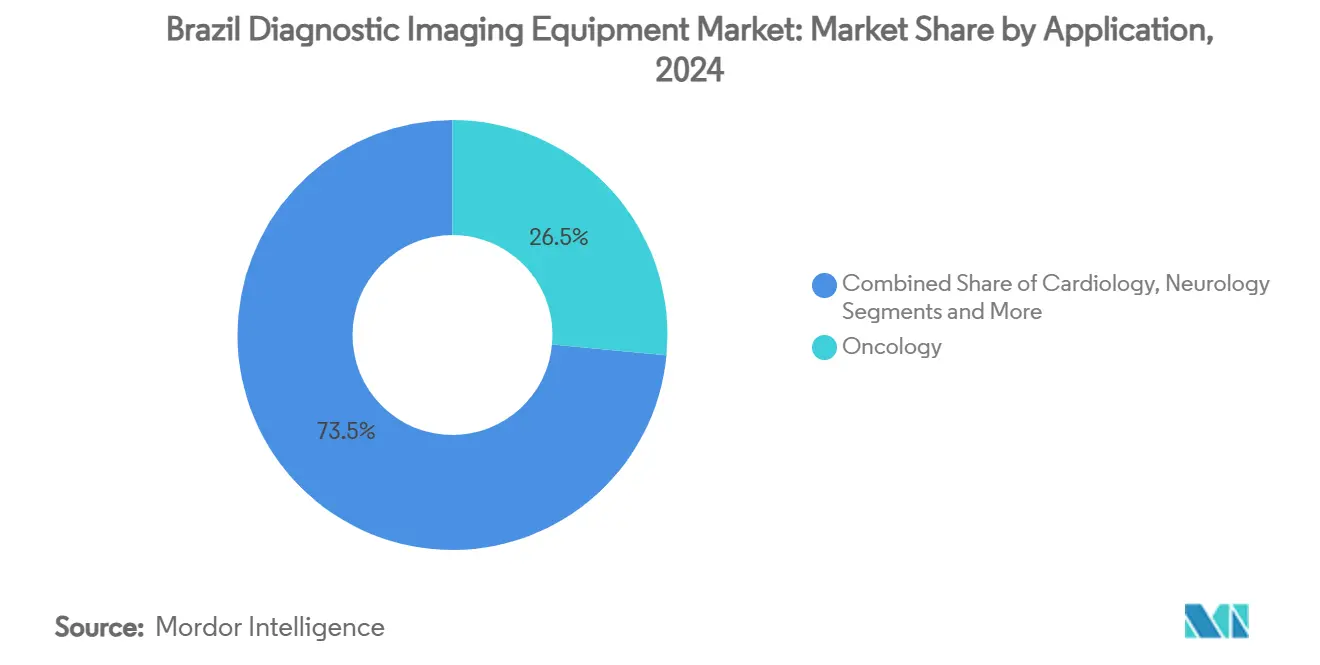
Note: Segment shares of all individual segments available upon report purchase
By End-user: Hospital Dominance Amid Diagnostic Center Growth
Hospitals bear 58.65% of Brazil diagnostic imaging equipment market share, thanks to 7,191 facilities under SUS contracts and private chains. Diagnostic imaging centers will expand at a 6.85% CAGR as Fleury, Alliança, and Diagmed add sites near shopping malls and employer campuses. The diagnostic center segment benefits from approximately 25% of Brazilians opting for private health insurance to avoid delays in public healthcare delivery, creating sustained demand for specialized imaging services.
Specialty clinics leverage AI-equipped low-field MRI for orthopedic and oncology sub-segments, reflecting sector diversification and fresh demand pipelines into the Brazil diagnostic imaging equipment market. The end-user landscape evolution reflects Brazil's healthcare system maturation, with increasing specialization and private sector participation driving demand for premium imaging equipment and advanced diagnostic capabilities across both institutional and outpatient settings.
Geography Analysis
The Southeast region contains the bulk of installed scanners and hosts most private insurance lives and academic hospitals, giving it the largest regional share in the Brazil diagnostic imaging equipment market. Abundant service engineers and port proximity streamline import clearance and field support.
Southern states like Santa Catarina trail closely, buoyed by recent mergers that upgraded local park fleets. The Northeast posts the fastest growth through 2030, riding targeted SUS funding, telehealth pilots and mobile CT caravans that bridge historic access gaps. Projects such as UBS+Digital recorded high patient satisfaction and trained hundreds of staff in tele-triage, validating the region’s latent demand.
The North remains under-served yet strategic because federal cancer-screening caravans prioritize Amazonian communities. Central-West shows application-specific momentum as Mato Grosso authorities scale prostate MRI after incidence spikes. Collectively, regional variation pushes vendors to flex both high-end and ruggedized product lines, expanding the Brazil diagnostic imaging equipment market footprint nationwide.
Competitive Landscape
The Brazil diagnostic imaging equipment market features moderate consolidation. GE Healthcare, Siemens Healthineers and Philips together hold the lion’s share, strengthened by in-country subsidiaries, modality-wide portfolios and sizable service fleets. GE collaborates with AWS on generative AI and with IONIC Health on remote console control, giving it a digital edge. Siemens invests heavily in R&D and just rolled out Luminos Q.namix and Magnetom Flow, aiming at cost-sensitive emerging markets. Philips leads in patent filings and bundled AI smart-speed MRI that cuts scan time yet lifts resolution.
Local disrupters elevate competition. Portal Telemedicine’s cloud platform processes 3,000 reports daily and keeps 134 PB of images, enabling tier-2 hospitals to access on-demand reads. Mobissom’s wireless ultrasound fills remote prenatal niches where cart systems never took hold. Resonandina runs mobile MRI trailers that slash capital hurdles for peripheral clinics.
Past graft probes prompted stricter procurement reviews, opening doors for transparency-minded suppliers. New entrants like United Imaging Healthcare promote price-performance CT lines and flexible financing, adding downward pricing pressure. With extended-warranty service, AI-subscription bundles, and cloud PACS link-ups, vendors attempt to lock clients into life-cycle contracts and secure recurring revenue streams in the Brazil diagnostic imaging equipment market.
Brazil Diagnostic Imaging Equipment Industry Leaders
GE Healthcare
Siemens Healthineers
Koninklijke Philips N.V.
Canon Medical Systems
Fujifilm Holdings Corp.
- *Disclaimer: Major Players sorted in no particular order
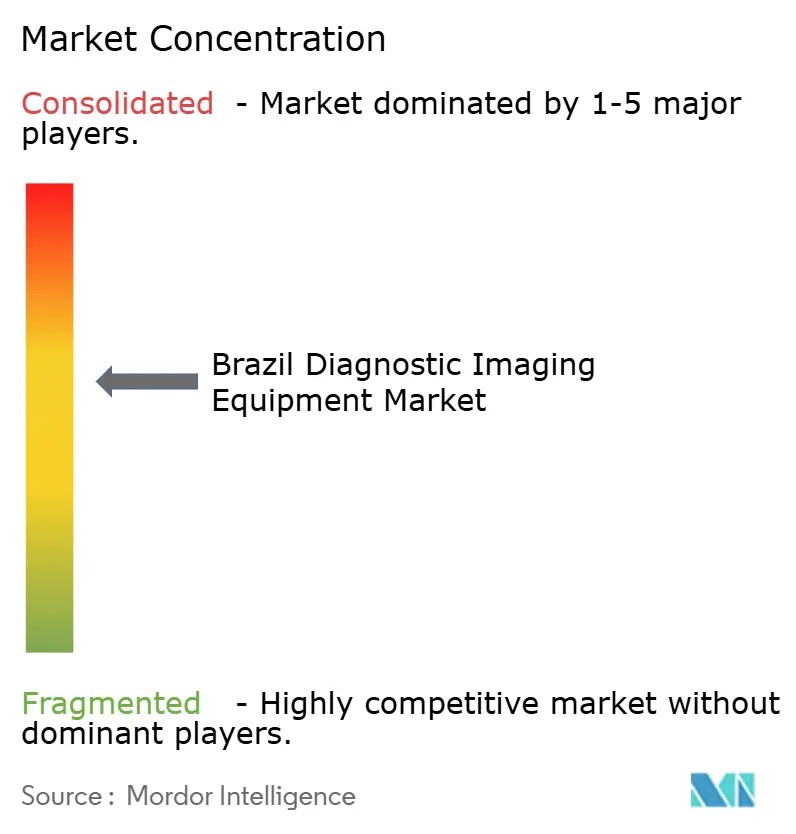
Recent Industry Developments
- April 2025: AGFA HealthCare and Konimagem showcased the Enterprise Imaging Platform at JPR 2025 in São Paulo.
- April 2024: MV released VIDA imaging viewer in Brazil, promising faster diagnostic workflows for radiology suites.
- April 2024: ANVISA confirmed mutual-recognition of device approvals from Australia, Canada, Japan and the United States starting June 2024.
- May 2024: Samsung Brazil demonstrated AI-enabled diagnostic ultrasound solutions during JPR 2024.
Brazil Diagnostic Imaging Equipment Market Report Scope
The report's scope covers the diagnostic imaging market, which covers a wide array of medical devices used for diagnostic purposes. It has applications in various oncological, orthopedic, gastroenterological, and gynecological fields.
The Brazilian diagnostic imaging equipment market is segmented by modality, application, and end user. The market is segmented by modality into MRI, computed tomography, ultrasound, X-ray, nuclear imaging, fluoroscopy, and mammography. Based on application, the market is segmented into cardiology, oncology, neurology, orthopedics, and other applications. By end user, the market is segmented into hospitals, diagnostic centers, and other end users. The report offers the value (in USD) for the above segments.
| X-ray |
| Ultrasound |
| Computed Tomography |
| MRI |
| Nuclear Imaging (PET/SPECT) |
| Fluoroscopy & C-arms |
| Mammography |
| Fixed Systems |
| Mobile & Hand-held Systems |
| Oncology |
| Cardiology |
| Neurology |
| Orthopedics |
| Obstetrics & Gynecology |
| Other Applications |
| Hospitals |
| Diagnostic Imaging Centers |
| Specialty Clinics |
| By Modality | X-ray |
| Ultrasound | |
| Computed Tomography | |
| MRI | |
| Nuclear Imaging (PET/SPECT) | |
| Fluoroscopy & C-arms | |
| Mammography | |
| By Portability | Fixed Systems |
| Mobile & Hand-held Systems | |
| By Application | Oncology |
| Cardiology | |
| Neurology | |
| Orthopedics | |
| Obstetrics & Gynecology | |
| Other Applications | |
| By End-user | Hospitals |
| Diagnostic Imaging Centers | |
| Specialty Clinics |
Key Questions Answered in the Report
What is the current value of the Brazil diagnostic imaging equipment market?
The Brazil diagnostic imaging equipment market size reached USD 1.31 billion in 2025.
Which modality is growing the fastest in Brazil?
MRI equipment is forecast to record the highest 7.96% CAGR through 2030 on the back of oncology and neurology demand.
How much of Brazil’s imaging hardware is imported?
Imports account for roughly 70% of total equipment value, exposing buyers to exchange-rate risk.
Why are mobile imaging systems important for Brazil?
Mobile and handheld units solve regional access gaps by bringing CT, MRI or ultrasound to remote areas lacking fixed facilities.
What regulatory change recently eased device approvals?
In 2024 ANVISA began recognizing clearances granted by regulators in Australia, Canada, Japan and the United States, trimming local review times.
Who are the leading vendors in Brazil?
GE Healthcare, Siemens Healthineers and Philips dominate across modalities, while Portal Telemedicine and Mobissom emerge in AI and portable niches.
